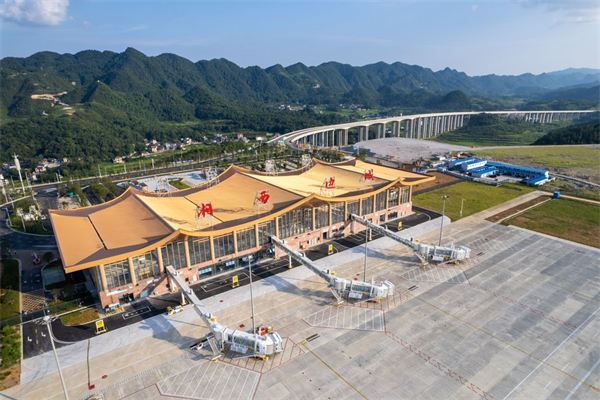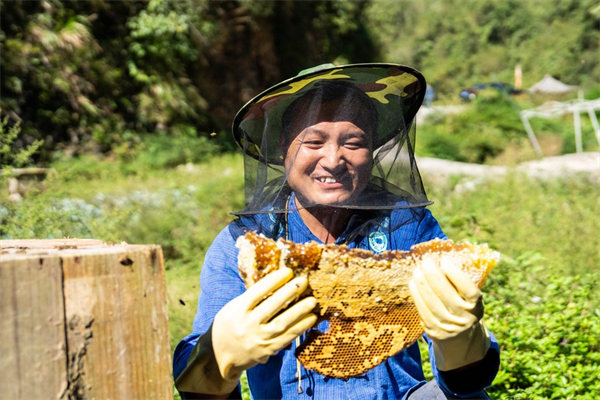
This aerial photo taken on Oct. 10, 2023 shows Shibadong Village in Xiangxi Tujia and Miao Autonomous Prefecture, central China's Hunan Province. (Xinhua/Chen Sihan)
CHANGSHA, Nov. 4 (Xinhua) -- During the late autumn season, Long Xianlan, hailing from Shibadong Village in the Xiangxi Tujia and Miao Autonomous Prefecture in central China's Hunan Province, was busy filming for an international program in his native village.
A group of media persons had come all the way from Laos to this small ethnic Miao village, tucked away in the Wuling Mountains, to learn about the secrets to China's poverty reduction success.
Shibadong Village is viewed as a "landmark" in China's poverty reduction efforts. In 2013, the idea of "targeted poverty alleviation" was first introduced at Shibadong Village. This pioneering notion focused on tailoring poverty alleviation efforts to different individuals, local conditions and causes of poverty. Since then, targeted poverty alleviation has spread from Hunan to the entire country, resolving the longstanding problem of absolute poverty.

A woman makes Miao embroidery at Shibadong Village in Xiangxi Tujia and Miao Autonomous Prefecture, central China's Hunan Province, Oct. 11, 2023. (Xinhua/Chen Sihan)
Long has been a witness to this transformation. An orphan in the Miao village, he was struggling with alcoholism a decade ago.
"My mother remarried after my father died early, and my sister died in an accident, too. I thought my life was doomed, and I became addicted to alcohol," Long said.
In 2013, Shibadong Village had a daunting poverty incidence rate of 57 percent, with an average per capita net income of only 1,668 yuan.
The concept of "targeted poverty alleviation" has changed the fate of the village as well as Long's life. In January 2014, the Huayuan County committee dispatched a team of "targeted poverty alleviation" workers to Shibadong Village, who tailored assistance measures for each poor family.
Under the guidance of the work team, Long started to learn beekeeping. Over time, he not only honed his expertise in the field but also helped hundreds of households in neighboring villages shake off poverty through beekeeping.

This aerial photo taken on Oct. 10, 2023 shows Shibadong Village in Xiangxi Tujia and Miao Autonomous Prefecture, central China's Hunan Province. (Xinhua/Chen Sihan)
Today, Long's annual income surpasses 400,000 yuan (about 55,713.4 U.S. dollars), and the per capita net income of villagers in Shibadong reached 23,505 yuan in 2022. "I hope my experiences can inspire people in some other corners of the world," said an emotional Long.
In a mere decade, the ethnic Miao village has experienced a profound transformation, with the most remarkable changes evident in its infrastructure.
Shi Laoji, a Shibadong villager, reminisces how challenging it was to transport pigs out of the village for sale in the past. "Maneuvering pigs along the narrow, slippery mountain trails was perilous," Shi said.
Today, the muddy roads of Shibadong Village have been replaced by asphalt roads and stone-paved pathways, and modern services like mobile phones, banks and post offices are easily accessible.

This aerial photo taken on Aug. 17, 2023 shows a view of Xiangxi Biancheng Airport in Laotianping Village of Xiangxi Tujia and Miao Autonomous Prefecture, central China's Hunan Province. (Xinhua/Chen Sihan)
In August this year, an airport was opened in the Xiangxi Tujia and Miao Autonomous Prefecture, offering the joy of air travel to many villagers like Shi.
The remarkable transformation of the impoverished village is closely tied to its industrial progress. "Shibadong has formed five industries, namely, tourism, mountain spring water, labor service, farming and Miao embroidery," said Long Ke, the Party chief stationed at the villlage.
"The villagers who used to work outside are now returning to work as guides in their native place, running farmhouses and homestays, and engaging in live broadcasting to sell agricultural specialties," Long Ke added.

A man collects honey at Shibadong Village in Xiangxi Tujia and Miao Autonomous Prefecture, central China's Hunan Province, Nov. 1, 2023. (Xinhua/Chen Sihan)
In 2022, Shibadong Village received 532,000 tourists and earned tourism revenue of 12 million yuan.
"There's a growing sense of happiness and fulfillment among our villagers," Long Ke said.
Nowadays, the village has also become a window for the world to understand China's poverty alleviation efforts. Over the past five years, Shibadong has welcomed over ten foreign delegations from countries including Spain, Namibia, Vietnam and the Philippines.
"I hope our small village can serve as a reference for countries and people in the world who aspire to get rid of poverty and live better lives," Long Xianlan said.
来源:enghunan.gov
编辑:谭婕倪